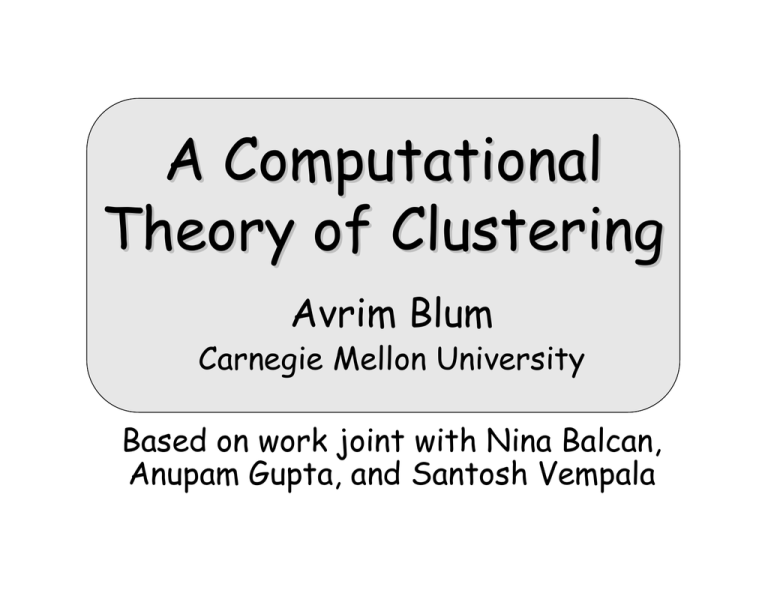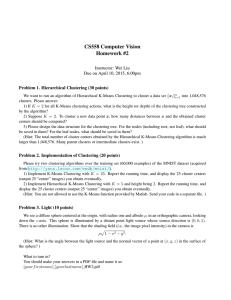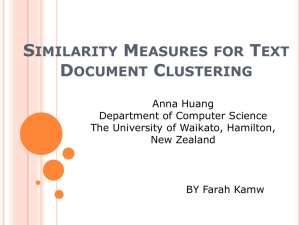A Computational Theory of Clustering Avrim Blum Carnegie Mellon University
advertisement

A Computational
Theory of Clustering
Avrim Blum
Carnegie Mellon University
Based on work joint with Nina Balcan,
Anupam Gupta, and Santosh Vempala
Point of this talk
• A new way to theoretically analyze and
attack problem of clustering. Fixes a
disconnect in previous formulations.
• Interesting theoretical structure. Will
show results in this framework, but also
many open questions too!
• Motivated by machine learning but you
don’t need to know any ML for this talk.
Clustering comes up everywhere
• Given a set of documents or search results,
cluster them by topic.
• Given a collection of protein sequences,
cluster them by function.
• Given a set of images of people, cluster by
who is in them.
• …
Standard theoretical approach
• View data as nodes in weighted graph.
– Weights based on some measure of similarity
(like # keywords in common, edit distance,…)
• Pick some objective to optimize like kmedian, k-means, min-sum,…
Standard theoretical approach
• View data as nodes in weighted graph.
– Weights based on some measure of similarity
(like # keywords in common, edit distance,…)
• Pick some objective to optimize like kmedian, k-means, min-sum,…
– E.g., k-median asks: find center pts c1, c2, …, ck
to minimize ∑x mini d(x,ci)
y
c1
x
z
c2
Standard theoretical approach
• View data as nodes in weighted graph.
– Weights based on some measure of similarity
(like # keywords in common, edit distance,…)
• Pick some objective to optimize like kmedian, k-means, min-sum,…
• Develop algorithm that approximates this
objective. (E.g., best known for k-median is 3+ε
approx. Beating 1 + 2/e ≈ 1.7 is NP-hard.)
A bit of a disconnect… isn’t our real
goal to get the points right??
Well, but..
• Could say we’re implicitly hoping that any c-approx
to k-median objective is ε-close pointwise to truth.
• This is an assumption about how the similarity info
relates to the target clustering.
• Why not make it explicit?
Example of result: for any c>1, this assumption implies
structure we can use to get O(ε)-close to truth.
Even for values where getting c-approx is NP-hard!
(Even ε-close, if all clusters are “sufficiently large”.)
“Approximate clustering without the approximation”
Well, but..
• Could say we’re implicitly hoping that any c-approx
to k-median objective is ε-close pointwise to truth.
• This is an assumption about how the similarity info
relates to the target clustering.
• Why not make it explicit?
More generally: what natural properties of similarity
info are sufficient to cluster well, and by what
kinds of algorithms?
Give guidance to designers of similarity measures, &
about what algs to use given beliefs about them.
Well, but..
• Could say we’re implicitly hoping that any c-approx
to k-median objective is ε-close pointwise to truth.
• This is an assumption about how the similarity info
relates to the target clustering.
• Why not make it explicit?
More generally: what natural properties of similarity
info are sufficient to cluster well, and by what
kinds of algorithms?
Analogy to learning: what concept classes are
learnable and by what algorithms?
General Framework
s]
rt
po
[s
[f
a
sh
io
n]
S set of n objects. [web pages, protein seqs]
∃ ground truth clustering. x, l(x) in {1,…,t}.
[topic, function]
Goal: clustering h of low error pointwise. err(h) = minσPrx∈S[σ(h(x)) ≠ l(x)]
Given a pairwise similarity function K(x,y) between objects.
Question: how related does K have to be to target to
be able to cluster well?
Similarity vs distance
• Using “similarity” instead of distance since don’t
want to require metric. Usually based on some
heuristic.
– “cosine similarity” between documents (size of
intersection / size of union)
– Smith-Waterman score for bio sequence data.
– In general, might not even be symmetric.
• In learning, very common as kernel functions. K is a
kernel if corresponds to dot-product in implicit
space. K(x,y) = ΦK(x)·ΦK(y). [this is why we use “K”]
Given a pairwise similarity function K(x,y) between objects.
Question: how related does K have to be to target to
be able to cluster well?
What conditions on a similarity measure
would be enough to allow one to cluster well?
• Using “similarity” instead of distance since don’t
want to require metric. Usually based on some
heuristic.
– “cosine similarity” between documents (size of
intersection / size of union)
– Smith-Waterman score for bio sequence data.
– In general, might not even be symmetric.
• In learning, very common as kernel functions. K is a
kernel if corresponds to dot-product in implicit
space. K(x,y) = ΦK(x)·ΦK(y). [this is why we use “K”]
Given a pairwise similarity function K(x,y) between objects.
Question: how related does K have to be to target to
be able to cluster well?
What conditions on a similarity measure
would be enough to allow one to cluster well?
Will lead to something like a PAC model for
clustering.
Alternatively, model data as mixture of Gaussians
or other distributions. (Generative model)
Here, we don’t want to make distributional
assumptions. (compare to learning a linear
separator). Can view as advice to designer of
similarity function.
What conditions on a similarity measure
would be enough to allow one to cluster well?
Will lead to something like a PAC model for
clustering.
This talk is based on two pieces of work:
• Formulation of framework and analysis of
different natural properties [with Nina Balcan
and Santosh Vempala]
• Looking specifically at implicit properties
used in approximation algorithms [with Nina
Balcan and Anupam Gupta]
s]
rt
po
[s
What conditions on a similarity measure
would be enough to allow one to cluster well?
[f
a
sh
io
n]
Protocol
∃ ground truth clustering for S
i.e., each x in S has l(x) in {1,…,t}.
Input
S, a similarity function K.
Output Clustering of small error.
The similarity function
K has to be related to
the ground-truth.
What conditions on a similarity measure
would be enough to allow one to cluster well?
Here is a condition that trivially works:
Suppose K has property that:
• K(x,y) > 0 for all x,y such that l(x) = l(y).
• K(x,y) < 0 for all x,y such that l(x) ≠ l(y).
If we have such a K, then clustering is easy.
Now, let’s try to make this condition a little
weaker….
What conditions on a similarity measure
would be enough to allow one to cluster well?
Suppose K has property that all x are
more similar to points y in their own
cluster than to any y’ in other clusters.
• Still a very strong condition.
Problem: the same K can satisfy for two very
different clusterings of the same data!
baseball
Math
basketball
Physics
What conditions on a similarity measure
would be enough to allow one to cluster well?
Suppose K has property that all x are
more similar to points y in their own
cluster than to any y’ in other clusters.
• Still a very strong condition.
Problem: the same K can satisfy for two very
different clusterings of the same data!
baseball
Math
basketball
Physics
Unlike learning,
you can’t even test
your hypotheses!
Let’s weaken our goals a bit…
1. OK to produce a hierarchical clustering
(tree) such that correct answer is apx
baseball
some pruning of it.
Math
–
E.g., in case from last slide:
all documents
sports
baseball basketball
–
science
basketball
Physics
math physics
Can view as starting at top and saying “if any
of these clusters is too broad, just click and
I will split it for you”
Let’s weaken our goals a bit…
1. OK to produce a hierarchical clustering
(tree) such that correct answer is apx
baseball
some pruning of it.
Math
–
E.g., in case from last slide:
all documents
sports
baseball basketball
science
basketball
Physics
math physics
2. OK to output a small # of clusterings
such that at least one has low error.
–
Define clustering complexity of a property
as minimum list length needed to guarantee
at least one clustering is ε-close to target.
Then you can start getting somewhere….
1.
“all x more similar to all y in their own cluster
than to any y’ from any other cluster”
is sufficient to get hierarchical clustering such that target is
some pruning of tree. (Kruskal’s / single-linkage works)
Proof: laminar before ⇒ laminar after.
Then you can start getting somewhere….
1.
“all x more similar to all y in their own cluster
than to any y’ from any other cluster”
is sufficient to get hierarchical clustering such that target is
some pruning of tree. (Kruskal’s / single-linkage works)
Proof: laminar before ⇒ laminar after.
Then you can start getting somewhere….
1.
“all x more similar to all y in their own cluster
than to any y’ from any other cluster”
is sufficient to get hierarchical clustering such that target is
some pruning of tree. (Kruskal’s / single-linkage works)
2. Weaker condition: ground truth is “stable”:
For all clusters C, C’, for all A⊂C,
A’⊂C’: A and A’ are not both
more similar to each other than
to rest of their own clusters.
[E.g., property 1 plus internal noise]
K(x,y) is
attraction
between x
and y
Analysis for slightly simpler version
Assume for all C, C’, all A⊂C, A’⊆C’, we have
K(A,C-A) > K(A,A’),
Avgx∈A, y∈C-A[K(x,y)]
and say K is symmetric.
Algorithm: average single-linkage
• Like Kruskal, but at each step merge pair of
clusters whose average similarity is highest.
Analysis: (all clusters made are laminar wrt target)
• Failure iff merge C1, C2 s.t. C1⊂C, C2∩C = φ.
Analysis for slightly simpler version
Assume for all C, C’, all A⊂C, A’⊆C’, we have
C3
K(A,C-A) > K(A,A’),
Avgx∈A, y∈C-A[K(x,y)]
and say K is symmetric.
C2
C1
Algorithm: average single-linkage
• Like Kruskal, but at each step merge pair of
clusters whose average similarity is highest.
Analysis: (all clusters made are laminar wrt target)
• Failure iff merge C1, C2 s.t. C1⊂C, C2∩C = φ.
• But must exist C3⊂C s.t. K(C1,C3) ≥ K(C1,C-C1), and
K(C1,C-C1) > K(C1,C2). Contradiction.
What if asymmetric?
Assume for all C, C’, all A⊂C, A’⊆C’, we have
K(A,C-A) > K(A,A’),
Avgx∈A, y∈C-A[K(x,y)]
[Think of K as “attraction”]
and say K is symmetric.
Algorithm breaks down if K is not symmetric:
0.5
0.1
0.25
Instead, run “Boruvka-inspired” algorithm:
– Each current cluster Ci points to argmaxC K(Ci,Cj)
j
– Merge directed cycles. (not all components)
Relaxed conditions
Going back to:
1.
“strict separation”
“all x more similar to all y in their own cluster
than to any z from any other cluster”
Let’s consider a relaxed version:
1’. “Exists S’ ⊆ S, |S’| ≥ (1-α)|S|, satisfying 1.”
Can show two interesting facts:
A. Can still efficiently get a tree of error α.
(assuming all target clusters are large).
B. This property is implied by (2,ε) k-median
property, for α=4ε. (Assume metric. “more similar” = “closer”)
Relation to apx k-median assumption
• Suppose any 2-apx k-median solution must be
ε-close to the target. (for simplicity, assume target=OPT)
• But doesn’t satisfy 1. x is closer to z in
other cluster than to y in own cluster.
y
– Delete & repeat.
– Can’t repeat > ε n times.
x
z
– Else, move all x’s to corresponding z’s
cluster: at most doubles objective.
• d(x,cz) d(x,z)+cost(z) d(x,y)+cost(z) cost(x)+cost(y)+cost(z).
Relation to apx k-median assumption
• (2,ε) k-median property ⇒ O(ε)-relaxed
separation property.
• O(ε)-relaxed separation property ⇒ produce
tree s.t. some pruning is O(ε)-close. (assuming
all target clusters are large).
• Can actually directly go from (c,ε) k-median
property to single O(ε)-close clustering, for
any c>1. (ε-close if all target clusters are large).
– Also for k-means, min-sum.
How can we use the (c,ε) kmedian property to cluster,
without solving k-median?
Clustering from (c,ε) k-median prop
• Suppose any c-apx k-median solution must be
ε-close to the target. (and for simplicity say
target is k-median opt, & all cluster sizes > 2εn)
• For any x, let w(x)=dist to own center,
w2(x)=dist to 2nd-closest center.
• Let wavg=avgx w(x).
x
• Then:
– At most εn pts can have w2(x) < (c-1)wavg/ε.
– At most 5εn/(c-1) pts can have w(x)≥(c-1)wavg/5ε.
• All the rest (the good pts) have a big gap.
Clustering from (c,ε) k-median prop
– At most εn pts can have w2(x) < (c-1)wavg/ε.
– At most 5εn/(c-1) pts can have w(x)≥(c-1)wavg/5ε.
• All the rest (the good pts) have a big gap.
Clustering from (c,ε) k-median prop
– At most εn pts can have w2(x) < (c-1)wavg/ε.
– At most 5εn/(c-1) pts can have w(x)≥(c-1)wavg/5ε.
• All the rest (the good pts) have a big gap.
• Define critical distance dcrit=(c-1)wavg/5ε.
• So, a 1-O(ε) fraction of pts look like:
y
dcrit
2dcrit
x
> 4dcrit
dcrit
> 4dcrit
z
dcrit
Clustering from (c,ε) k-median prop
• So if we define a graph G connecting any two
pts within distance 2dcrit, then:
– Good pts within cluster form a clique
– Good pts in different clusters have no common
nbrs
• So, a 1-O(ε) fraction of pts look like:
y
dcrit
2dcrit
x
> 4dcrit
dcrit
> 4dcrit
z
dcrit
Clustering from (c,ε) k-median prop
• So if we define a graph G connecting any two
pts within distance 2dcrit, then:
– Good pts within cluster form a clique
– Good pts in different clusters have no common
nbrs
• So, the world now looks like:
Clustering from (c,ε) k-median prop
• If all clusters have size > 2b+1, where b = #
bad pts = O(εn/(c-1)), then:
– Create graph H where connect x,y if share > b
nbrs in common in G.
– Output k largest components in H.
• So, the world now looks like:
Clustering from (c,ε) k-median prop
• If clusters not so large, then need to be a
bit more careful but can still get error O(ε).
• E.g., now could have some clusters dominated
by bad pts….
• So, the world now looks like:
O(ε)-close → ε-close
• Back to the large-cluster case: can actually
get ε-close. (for any c>1, but “large” depends on c).
• Idea: Really two kinds of bad pts.
– At most εn “confused”: w2(x)-w(x) < (c-1)wavg/ε.
– Rest not confused, just far: w(x)≥(c-1)wavg/5ε.
• Can recover the non-confused ones…
O(ε)-close → ε-close
• Back to the large-cluster case: can actually
get ε-close. (for any c>1, but “large” depends on c).
• Given output C’ from alg so far, reclassify
each x into cluster of lowest median distance
– Median is controlled by good pts, which will pull
the non-confused points in the right direction.
Properties Summary
Property
Model, Algorithm
Clustering
Complexity
Strict Separation
Hierarchical, Linkage based
Θ(2k)
Stability, all subsets.
Hierarchical, Linkage based
Θ(2k)
(Weak, Strong, etc)
Average Attraction
List, Sampling based & NN
2
[kΩ(k/γ),kO(k/γ )]
(Weighted)
Stability of large
subsets
Hierarchical, list and refine
2
(running time kO(k/γ ))
Θ(2k)
relaxed separation
Hierarchical , list and refine
Θ(2k)
(c,ε) k-median
Greedy + refining
1
How about weaker conditions?
What if just have: all (most) x satisfy
Ex’∈C(x)[K(x,x’)] > Ex’∈C’[K(x,x’)]+γ (∀C’≠C(x))
Not sufficient for hierarchy.
But can produce a small list of clusterings s.t.
at least one is good:
2…)
O(k/γ
§ Upper bound k
. [doesn’t depend on n]
§ Lower bound ≈ kΩ(k/γ).
Upper and lower bounds on “clustering
complexity” of this property.
Can also analyze inductive setting
• View S as just a random subset from
larger instance space X.
• Property holds wrt X.
• Given S, want to:
– A. produce good clustering of S.
– B. be able to insert new points in streaming
manner as they arrive.
Can also analyze inductive setting
Assume for all C, C’, all A⊂C, A’⊆C’, we have
K(A,C-A) > K(A,A’)+γ
Draw sample S:
– Need to argue that whp K(A,S∩C-A) is good
estimate of K(A,C-A) for all A⊆S for suff lg S.
– A sample cplx type argument using “regularity”
type results of [AFKK].
Once S is hierarchically partitioned, can insert
new points as they arrive.
Like a PAC model for clustering
• PAC learning model: basic object of study is
the concept class (a set of functions). Look
at which are learnable and by what algs.
• In our case, basic object of study is a
property: like a data-dependent concept
class. Want to know which allow clustering
and by what algs.
Conclusions
What properties of a similarity function are
sufficient for it to be useful for clustering?
– Target function as ground truth rather than
graph as ground truth. Graph is just produced
using a heuristic!
– To get interesting theory, helps to relax what
we mean by “useful”.
– Can view as a kind of PAC model for clustering.
– A lot of interesting directions to explore.
Conclusions
–
–
–
Natural properties (relations between sim fn
and target) that motivate spectral methods?
Efficient algorithms for other properties?
E.g., “stability of large subsets”, (c,ε)
property for other clustering objectives.
Other notions of “useful”.
a small DAG
instead ofto
a tree?
A• lotProduce
of interesting
directions
explore.
–
•
–
…
Others based on different kinds of feedback?






